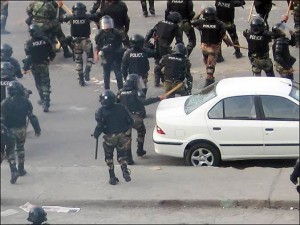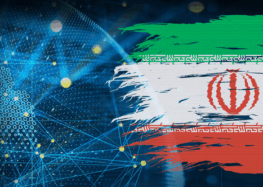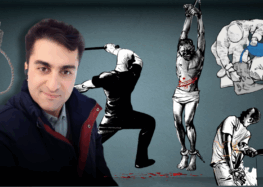Detailed Eyewitness Account of Tehran Protest on 20 June 2009
Susan Mohammadkhani Ghiasvand
(21 June 2009) Yesterday afternoon, 20 June 2009, the people of Tehran came out into the streets following a concerted effort on the part of the Iranian government to cancel the gathering through the use of state media, the spread of a large amount of rumors alongside threats against political groups and activists.
It was announced that on Friday there would be a march by the people of Tehran organized by Karroubi [one of] the reformist presidential candidates. But this plan was canceled due to [unexplained] circumstances and postponed til Saturday.
From 2:00 PM on Saturday, two hours before the start of the organized demonstrations of the people of Tehran, the city took on a militarized form. Various security and military groups surrounded Azadi (Freedom) Square. The security forces were armed with batons, clubs, tear gas, masks and cables. Some also had Uzi guns. I am presuming that they were Uzis based on the short barrel and the Kalashnikov cartridges. I am quite sure that the weapons were not G3’s because I know that the G3 is the special weapon of the army, however, there were no members of the army amongst these various military forces. There were a large number of black vehicles belonging to the Special Forces around Azadi [Freedom] Square and throughout Azadi Avenue. Some of these vehicles were specifically presetnt for carrying away the arrested. There were also hundreds of motorcycles belonging to the security forces along this route. The motors had been altered to make loud noises that resembled gun shots in order to create fear amongst the crowds, especially the women and children. In the skies over Tehran, there were helicopters belonging to the Revolutionary Guard’s Air Unit. The central lane of Azadi Avenue was cleared for the easy passage of the security vehicles and the motorcycles which would travel up and down the Avenue continuously and jointly. The riders of these vehicles would wave their batons and clubs above their heads and would chant “Haydar, Haydar, Haydar” or “Mola Amir al-Mo’menin” [both are appellations for Imam Ali] or “Ya Hossein, Ya Hossein.” Women on the sides of the streets would beat their chests and scream “You Basijis, may Hossein inflict pain on you” or “May the Prince of the believers [Ali] kill you, oh Revolutionary Guards” or “May Haydar [Ali] destroy you, o Godless zealots.” Children were screaming.
Thousands of people had gathered at Enghelab [Revolution] Square. The crowd was quiet and walking silently towards Azadi Square. After a certain distance, once the crowd had reached the Veterinary College, the demonstrators were attacked. The attackers were the Basij, Revolutionary Guards, Special Forces, Ansar-e Hezbollah and Hezbollah alongside plainclothesmen, anti-riot police and the RG Air unit. The crowd was large. As the attackers approached, the crowd turned around to escape. Many were pummelled by the crowd. The sound of screams and cries could be heard from the children in the crowd. People were forced to hold in their breath so as not to drown in the stampede. The military had no qualms in hitting women and children. Some of the soldiers would swing wires and cables in the faces of women and girls saying, “You whores, what the hell are you doing in the streets? This is a Muslim country.” Some of the girls, in order to escape the beatings, were pulling themselves up on the gates around the Veterinary College, but the soldier beat them mercilessly with wires and cables. There was blood splattering on the ground from the faces and bodies of many. When the crowd got further away from the Veterinary College, there remained remnants of shoes, cell phones, jewelery, wrist watches, purses and green banners all over the streets and side walks. The military showed no mercy towards the wounded and those who had passed out. They would beat them with batons and clubs. At every intersection, the security forces had attacked the people in order to put a wedge between them and stop them from reaching Azadi Square. People were looking for other ways to get to Azadi Square through the back alleys and streets. Others stayed on Azadi Boulevard thinking that they could forge through to the Square. People were no longer quiet. In some places, battles ensued between the people and the security forces. Some still believed that it’s better to continue the protests through silence and non-violence. Others would say, “we have been beaten for a couple of days now. How many more killed and how many more days of beatings before we realize that this club-wielding government will not listen to logic and sensibility. We need to speak to them in their own language.”
Helicopters continued to hover over people’s heads. They role was to identify the areas that needed more security forces. A few minutes after the helicopters found the women, cars and motorcycles converged on the area. Many of them were wearing masks. The women ran away. The sound of the motorcycles were frightening. The women were beaten again and tear gas was thrown at them. You could hear the women’s cries. The soldiers across the street were cheering as the women were being beaten and you could hear Allaho Akbar from them. The drivers would step on their gas and would shout “There is one part and that’s the Party of God [Hezbollah]” and “Long live Hezbollah.” Women escaped into the side streets where the battles between the military forces and the people were continuing. There was tear gas everywhere. A number of the demonstrators were soldiers from [the Iran-Iraq] War who had been victims of chemical weapons and their conditions were becoming critical because of the tear gas. A few were laying about in the street flailing to death, grabbing the air with their hands as if all they needed was a fist full of air. Some of the wounded were saying that they are War veterans whose wounds had reopened as a result of the beatings. They claimed that their bodies still had shrapnel. The ambulances were trying to quickly remove people, but people did not trust the drivers nor did they know where they would be taken, so they refused to get on the ambulance.
In the side streets, the military send backups to the units that were already there. There were reports that in areas that saw strong skirmishes and where people had put up strong resistance, helicopters from the RG’s Air Unit were spraying with a liquid that burned the face and eyes much worse than the tear gas. People entered nearby homes and everyone was looking for a water hose. But water exacerbated the pain. Everyone was holding their face and eye and crying out loud. At this moment people started condemning Mr. Khamenei, the Leader of Iran. They claimed, “the more we tried to be measured, the more rabid they became.”
The para-militaries started attacking the homes where people had found refuge from the burning liquid. They would kick in the doors and windows and enter the homes. Where they couldn’t enter, they would break the windows and throw a tear gas in front so the fumes would go inside. People who had just been burned by the liquid from the helicopters were now being attacked with tear gas. They reluctantly left the homes and were immediately met with security forces with wires and clubs and batons. The soldiers would hit people while chanting “Allaho Akbar.” In the areas where the confrontations were strongest and people were being beaten the most, slogans against Khamenei were the loudest. People in those neighborhoods weren’t just demanding new elections and chanting against the President, but were demanding the abdication of Khamenei from power. In the areas with most combat, the soldiers would attack passing cars as well and would break their windows. The people living in the neighborhood didn’t have the right to come to their doors, windows, balconies or rooftops because they would have surely been met with an attack from the para-militaries. But people continued. Residents would go to their rooftops and would report on the police activities in the streets to the demonstrators.
There were very serious confrontations in the north and south side of Navvab intersection and Jeyhoon streets. People continued to resist. It was like this in Tehran til 10 PM. After that, the number of people dwindled and the military increased. Azadi Avenue had turned into a military parade. The central lane had remained opened for military vehicles. At the intersections, they would check the men and women’s purses and would confiscate all cell phone. People returning from shopping would be arrested, whether or not they participated in the demonstrations. They would arrest whomever they wanted.
Para-militaries and members of the Information and Security Agency searched for people in hospitals. Many of the wounded wouldn’t use their real names when entering hospitals to avoid being caught later. The para-militaries would question people in the hospitals with total disregard to the people’s physical conditions. The sick didn’t know to cry or to answer questions.
High schools, large buildings belonging to the traffic police, the Labor Ministry building and various other places on Azadi Avenue were filled with military forces who would use these sites to rest, re-group and re-fuel.
At 10 PM, people who had continued the struggle in Jayhoon Street were surrounded from various sides. No one was allowed to enter the street. Many ambulances were entering the street with their sirens blasting. It wasn’t clear what was happening there, but we could hear gun shots. The sound of people’s screams mixed with the sound of ambulance sirens taking dead people or the wounded to hospitals. No one knew what was going on inside. You could hear Allah-o Akbar from some rooftops. Soldiers were trying to quiet people by shouting and throwing stones at houses. I waited til the street became empty and I asked permission to enter Jayhoon Street but they wouldn’t let me. If a car would slow down close to Jayhoon street, the soldiers would attack them with clubs from every side and break their windows. Some of the drivers were also arrested. I waited for a miracle, for someone to come out alive from the street and tell me what had happened but there was no one. They had either escaped far or their voices had been stifled on the spot. Even the military men weren’t exiting. Only the ambulances were going in and out. No one could stop around the head of the street. And those who tried to go up on the pedestrian walkway would get beaten away. A large number of soldiers armed with weapons for spreading mustard gas, tear gas and other gases rushed into Jayhoon street. No one had the right to cross the street. I asked someone for the time and it was 10:55. Azadi Avenue was filled with security agents and a few people were milling about as well. There was no reason to wait around and I wanted to find out what had happened in other parts of the demonstration route so I started walking towards Azadi Square. The various military groups were marching in large units, holding batons and clubs. Motorcycles were going up and down two sides of the street, filling the whole city with their screech. When crossing, they would hit their batons on the rails in the middle of the street making a horrendous noise. They would say, “Tonight only the sound of Hezbollah should be heard in the city. Long live Hezbollah.”
I reached the Basij Resistance barracks where a large number of security forces had gathered with their motorcycles and cars. One of the men announced, “all those who have ran out of gas, come and get some, the gasoline shipment has arrived.” The soldiers were sitting on the sidewalks, some stretching out their legs. I could have crossed the street, but I decided to continue walking down the sidewalk so they would have to pull back their legs. I tried to catch their eyes so they would see the anger in my face. They just looked and said nothing. This is how it was til Azadi Square. Every ten meters or so there was a group of them with their motors, cars in the streets or around the sidewalk. And it was the same all around Azadi Square. The soldiers had eaten their meal and had thrown their containers on the grass. Some had stretched out alongside the garbage and were resting. The Square wasn’t lit very well, I had to strain my eyes to make out the soldiers. But I wanted to look at them cause I felt that if I didn’t, they would presume that I was afraid.
It’s past midnight, I catch the first car I can to go home. In the car, I hear for the first time that there had been a bombing at the Imam’s shrine. The number of casualties still won’t clear. But some people were celebrating and honking their horns. I don’t like what I am seeing, I am angry at whoever kills another person, whether it’s a Basij, a plainclothes or their counterparts: it makes no difference to me. I slowly leave Tehran: with the smoke and bullets, the blood and screams, the screeching of the women and children. How many are mourning tonight? How many injured? Where are the arrested? No one knows anything.
From Saturday morning June 20, the families of the arrested gathered in front of the Revolutionary Court. The number of arrested is estimated at 400. Families have no news of the health or the whereabouts of their loved ones and the Revolutionary Court and other governmental agencies have not given any definitive answers to their enquiries. Among these families are also the families of the students who had been arrested recently.
The IRIB announced that today there had been no scuffles in Tehran today but we have heard unconfirmed news that there had been sporadic fights in the city.
The IRIB has concentrated its one-sided reporting to news of the beating of a soldier, destruction of public property and the burning of parts of a mosque. The IRIB has not shown any images of the beating and suppression of thousands of people in Tehran at the hands of the military forces. Not even one scene or image.
There is some news of a planned general strike. The protesters are resolute in their desire to show their opposition of the announced fraudulent election results.
People believed that no leader would order the killing of his own people as Mr. Khamenei did from his podium at Friday prayers. Unless he has become an autocratic dictator and his rule has become thoroughly authoritarian.







